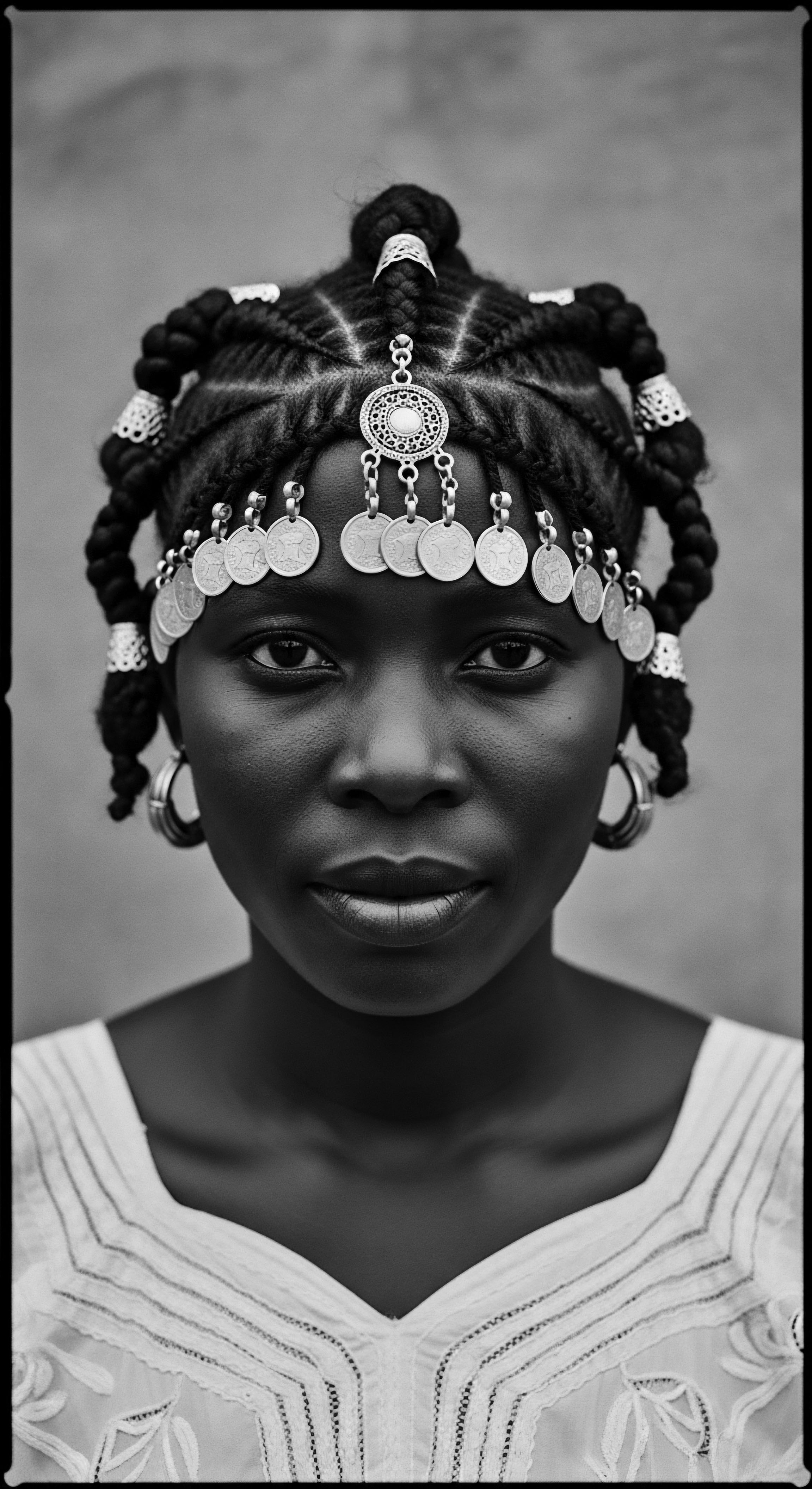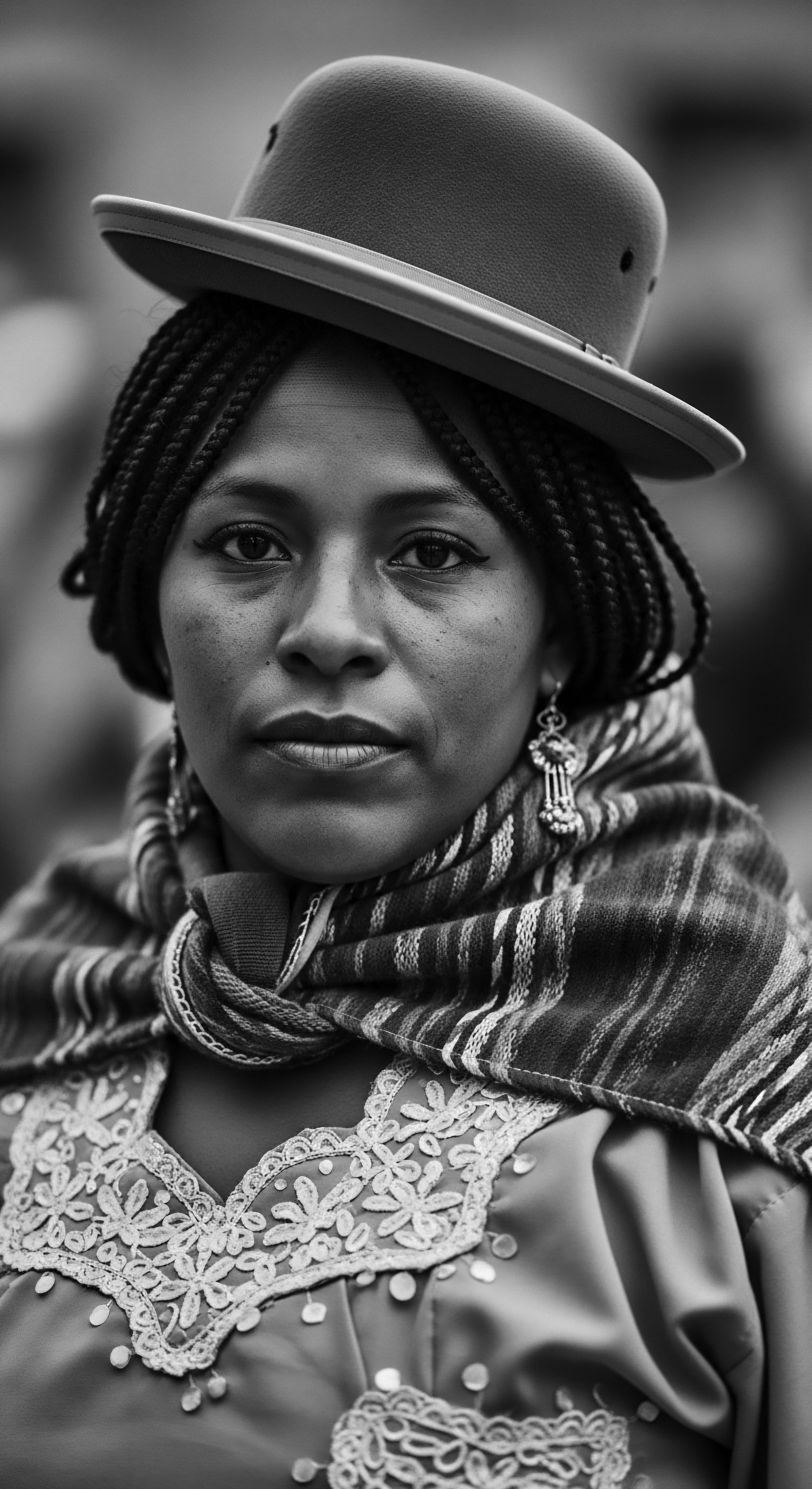
Fundamentals
The African Gourd Heritage represents a profound lineage of wisdom, connecting the elemental biology of the gourd plant with the intricate practices of textured hair care and identity across the vast African continent and its diaspora. It is an acknowledgment of the gourd, not merely as a simple vessel or tool, but as a living archive of ancestral knowledge, resourcefulness, and cultural resilience. This legacy speaks to centuries of ingenuity where natural resources were understood, honored, and applied in ways that nurtured both the physical well-being of hair and the spiritual essence of individuals and communities.
Consider the definition of this heritage ❉ it encompasses the historical and contemporary uses of various gourd species—such as Calabash (Lagenaria siceraria), Luffa (Luffa aegyptiaca), and others—in traditional African hair care. This includes their application as containers for precious oils and concoctions, as implements for detangling and styling, and as symbolic elements in rites of passage centered on hair. The enduring meaning embedded within this heritage points to a profound relationship between humanity, nature, and the continuous thread of generational knowledge passed down through the ages.
From the very soil that nourishes them, gourds offer their bounty, shaping the practices that protect and adorn textured coils and strands. This foundational understanding allows us to appreciate the foresight of ancestors who recognized the inherent value within these natural forms, transforming them into indispensable components of beauty and identity.
The African Gourd Heritage acknowledges the gourd as a living archive of ancestral knowledge, resourcefulness, and cultural resilience in textured hair care.

Echoes from the Source ❉ The Gourd’s Biological Genesis
The journey of understanding African Gourd Heritage begins with the gourd itself, an ancient plant family (Cucurbitaceae) with roots deeply entwined with human civilization. Long before manufactured plastics or ceramics, gourds provided a versatile, biodegradable, and accessible resource for daily life across Africa. Their hard shells, once dried, offered durable and lightweight containers, while their fibrous interiors could be transformed into cleansing implements.
- Lagenaria Siceraria ❉ Often known as the calabash gourd, this species has been cultivated for thousands of years. Its fruits, varying greatly in size and shape, are predominantly used after drying for containers, utensils, and musical instruments. In hair care, its sturdy shell made it ideal for fashioning scoops for water or oils during cleansing rituals, or as mixing bowls for herbal preparations.
- Luffa Aegyptiaca ❉ The luffa gourd, distinct from the calabash, develops a dense network of fibers within its fruit. When fully mature and dried, these fibers form a natural sponge, historically prized for gentle exfoliation and cleansing. For textured hair, particularly in pre-shampoo eras, the subtle abrasive yet soft quality of a luffa could aid in dislodging scalp buildup and distributing natural oils without harshness.
- Cucurbita Species ❉ While some members of this genus, like pumpkins and squashes, are primarily food sources, their larger, hard-shelled varieties have also historically found utility in broader African material culture, occasionally extending to storage related to personal care, including hair ingredients.
The adaptability of these plants, thriving in diverse African climates, ensured their widespread availability. The knowledge of how to cultivate, harvest, and prepare gourds for specific purposes was itself a significant part of the heritage, passed down through generations. This understanding extended to knowing which gourd shapes were best suited for particular hair tools or which parts of the plant, like the seeds of certain gourds, held valuable oils.

Ancient Practices ❉ Gourds as Ancestral Hair Implements
Across various African societies, the gourd’s versatility was ingeniously applied to the art of hair care. Before the advent of modern tools, ancestral communities fashioned implements from nature’s bounty. The gourd was a readily available, sustainable material that could be shaped with skill and intention to meet specific hair needs. These traditional applications underscore the fundamental connection between daily grooming and a deeply integrated relationship with the natural world.
For instance, smoothed sections of calabash gourds became practical scoops for applying water or liquid concoctions to the scalp and hair during communal washing rituals. In societies where hair cleansing involved natural clays, fermented grains, or herbal infusions, gourds served as indispensable mixing bowls, their non-reactive surfaces suitable for preparing these potent, earthy mixtures. The gentle, rounded edges of certain gourd fragments could even be employed as rudimentary yet effective detangling tools, carefully working through textured coils to minimize breakage.
| Gourd Form/Part Dried Calabash Shells |
| Traditional Hair Care Use Used as mixing bowls for natural hair cleansers (e.g. clay, plant ash), containers for precious oils, and scoops for water application during communal hair rituals. |
| Gourd Form/Part Luffa Sponges |
| Traditional Hair Care Use Utilized for gentle scalp exfoliation, aiding in the removal of buildup and stimulating circulation, as well as for distributing cleansing agents evenly across strands. |
| Gourd Form/Part Gourd Shards (Smoothed) |
| Traditional Hair Care Use Fashioned into rudimentary detangling tools, carefully separating textured hair to prevent knots and breakage, demonstrating ancestral ingenuity in material adaptation. |
| Gourd Form/Part Gourd Seeds/Oils |
| Traditional Hair Care Use From certain species, pressed oils (e.g. egusi oil from Citrullus lanatus) nourished hair and scalp, contributing to moisture retention and overall strand health. |
| Gourd Form/Part These applications reveal a deep ancestral understanding of gourds as practical and symbolic elements in hair wellness. |

Intermediate
Expanding upon the foundational understanding, the African Gourd Heritage represents not just a collection of historical facts but a living testament to cultural continuity and adaptive genius. It illustrates how materials drawn directly from the earth became central to personal expression and collective identity, particularly within the context of textured hair, which holds immense cultural weight in African and diasporic communities. This segment delves deeper into the meaning of the gourd beyond its utility, examining its symbolic resonance and its role in shaping hair practices as forms of cultural preservation and communication.
The gourd, in its diverse forms, often embodies principles of self-sufficiency and resourcefulness. Communities across Africa cultivated gourds with an intimate knowledge of their properties, ensuring a sustainable source for vital tools and containers. This intimate connection to the land and its offerings is a hallmark of ancestral wisdom, translating directly into hair care routines that were both effective and harmoniously aligned with the natural environment. The deliberate selection and preparation of a gourd for a specific hair purpose speaks volumes about the mindful approach to beauty and wellness.
The African Gourd Heritage is a living testament to cultural continuity, adaptive genius, and the profound meaning embedded in self-sufficiency through natural resources like the gourd.

The Tender Thread ❉ Gourd as a Conduit for Care and Community
The connection between the African gourd and hair heritage extends far beyond mere instrumentality; it becomes a conduit for communal care and the transmission of knowledge. In many African societies, hair care was a communal activity, a time for sharing stories, wisdom, and laughter. Gourds often played a silent, yet central, role in these gatherings.
- Communal Cleansing Rituals ❉ The large, hollowed calabashes served as shared basins for washing hair, especially for children or during rites of passage. This communal aspect reinforced social bonds and the collective responsibility for individual well-being. The act of washing hair together, using water dispensed from a gourd, was an act of nurturing and connection.
- Storage of Precious Ingredients ❉ Dried gourds were ideal for storing herbs, powdered clays, and plant-based butters used in hair treatments. Their natural insulation helped preserve these ingredients, ensuring their potency for future applications. This practice protected valuable ancestral formulations, safeguarding the efficacy of traditional care methods.
- Symbolic Adornment ❉ While less common for direct hair implements, small, intricately decorated gourds sometimes served as containers for hair adornments like beads or cowrie shells, or even as decorative elements themselves during ceremonial occasions. This reflected the gourd’s broader cultural significance as an item of beauty and spiritual connection.
This communal dimension of hair care, mediated by the presence of gourds, underscores the holistic approach to beauty that characterized ancestral practices. Hair was not an isolated aesthetic concern but an integral part of one’s identity, health, and community standing. The very act of preparing and using gourd implements or containers for hair treatments became a ritual, imbued with intentionality and shared cultural significance.

Cultural Narratives ❉ Gourds in the Lore of Hair and Identity
Within the rich tapestry of African oral traditions and cultural narratives, gourds often appear as symbols of life, sustenance, and continuation. This symbolism extends to their role in hair traditions, where hair itself is viewed as a spiritual antenna, a visible marker of identity, status, and heritage. The very act of engaging with a gourd for hair care or adornment could carry layers of meaning, connecting the individual to ancestral lines and cosmic forces.
Consider how the gourd’s round, protective form could symbolize the cyclical nature of life and growth, mirroring the continuous regeneration of hair. Its ability to hold and preserve vital substances—water, food, or potent herbal remedies—made it a natural metaphor for nurturing and safeguarding. This deeper connotation elevated the simple act of hair care into a ritual of self-preservation and ancestral reverence.
Beyond functional utility, the gourd’s presence in hair lore highlights a profound respect for natural materials and the wisdom of the earth. The selection, preparation, and sometimes elaborate decoration of gourds for use in personal care spoke to the artistry and spiritual intentionality embedded within daily life. This understanding is crucial for grasping the comprehensive delineation of African Gourd Heritage, extending it beyond mere object to encompass a philosophy of living.

Academic
The African Gourd Heritage, from an academic vantage point, constitutes a compelling domain of inquiry intersecting ethnobotany, material culture studies, historical anthropology, and the sociology of hair. Its definition transcends a simplistic recognition of gourds as physical tools, rather positioning them as critical cultural artifacts and biological resources whose utilization profoundly shaped and reflected identity, resilience, and knowledge systems within African and diasporic communities. This complex interplay of botanical properties, human ingenuity, and symbolic meaning provides a potent lens through which to examine the enduring legacy of textured hair care practices. The meaning of this heritage is deeply embedded in its capacity to serve as a tangible link to ancestral methodologies for personal care, particularly in societies where hair held, and continues to hold, immense spiritual, social, and aesthetic weight.
We approach this subject with an awareness that the seemingly humble gourd harbors a sophisticated narrative, challenging conventional notions of “primitive” tools. Instead, we see highly adapted, localized innovations that addressed specific needs for diverse hair textures long before globalized product markets existed. The meticulous preparation of a gourd for use in hair care, from selecting the right species and size to drying, hollowing, and sometimes curing or decorating, represents a complex set of traditional ecological knowledge passed down through oral tradition and practical demonstration. The very act of engaging with these natural vessels and implements was a pedagogical process, reinforcing cultural norms around beauty, hygiene, and the sacredness of the human body.
The African Gourd Heritage, from an academic lens, views gourds as critical cultural artifacts and biological resources that shaped identity and resilience in African communities, reflecting a complex interplay of botanical properties, human ingenuity, and symbolic meaning.

The Unbound Helix ❉ Gourd as a Symbol of Indigenous Hair Sovereignty
A particularly illuminating aspect of the African Gourd Heritage, demanding rigorous academic scrutiny, is its profound connection to the concept of Indigenous Hair Sovereignty, especially during periods of immense socio-political upheaval such as colonial expansion and the transatlantic slave trade. Here, the gourd ceases to be a mere utensil; it morphs into a quiet, yet powerful, symbol of cultural resistance and the unwavering preservation of selfhood. This is where we uncover a unique historical example, often overlooked in broader narratives of resistance, that powerfully illuminates the deeper significance of this heritage.
In examining the practices of enslaved Africans in the Americas, historical accounts and archaeological findings occasionally reveal the resourceful adaptation of gourds for hair care, maintaining a continuity with ancestral practices even under brutal conditions. While direct archaeological evidence of gourd combs specifically from enslaved African communities in the Americas is rarer due to their biodegradability, extensive evidence exists for gourd usage in other domestic and spiritual contexts, making their application in hair care highly probable and culturally consistent. The continuity of the knowledge system is the critical element.
For instance, detailed ethnographic studies from the early 20th century, particularly concerning Afro-descendant communities in the Caribbean and parts of the Southern United States, document the persistent use of natural materials for hair care, including plant-derived containers for hair oils and washes. These practices were not isolated acts but formed part of a larger continuum of self-care and cultural affirmation that quietly defied the dehumanizing forces of slavery.
One potent example comes from the Maroon communities, particularly in Suriname and Jamaica, who fiercely guarded their ancestral ways. These communities, forged by those who escaped enslavement, became bastions of preserved African cultural practices. Here, the continued use of calabash gourds for carrying water, cultivating crops, and serving food was explicit, but their role extended to personal care. Dr.
Sally Price and Richard Price, in their extensive anthropological work on Saramaka Maroons of Suriname, describe how daily life was imbued with connections to ancestral lands and practices. While not always directly detailing hair tools, their accounts illuminate a profound resourcefulness in adapting available natural materials for all aspects of daily life, including personal grooming and communal hygiene (Price & Price, 1999).
This deliberate choice to cultivate and utilize gourds, rather than adopt materials imposed by the colonizers or enslavers, represented a silent, yet formidable, act of defiance. The very act of preparing a natural cleanser in a calabash, or smoothing a gourd shard for detangling, affirmed a connection to a past that sought to be erased. This wasn’t merely about hair hygiene; it was about maintaining a spiritual and cultural umbilical cord to Africa. In spaces where overt rebellion was met with extreme violence, the subtle perpetuation of traditional practices, like those involving gourds for hair, became a vital strategy for preserving individual and collective dignity.
This practice is underpinned by what Dr. Gwendolyn Midlo Hall’s statistical analysis of enslaved African populations in Louisiana, using meticulous historical records, reveals about the retention of African cultural traits. While not directly referencing gourds and hair, her work illustrates that despite the horrors of the slave trade, specific African cultural retentions were remarkably persistent in certain communities and periods, often through subtle, daily practices that could evade scrutiny (Hall, 1992, p. 165).
The gourds, therefore, represent a localized, tangible manifestation of this broader statistical trend of cultural persistence. The ability of a community to maintain its traditional material culture, including tools for self-care, under such duress, speaks volumes about the intrinsic value and resilience of that culture. The hands that prepared the gourds for cleansing hair were the same hands that held onto ancestral memory, ensuring that the essence of their heritage remained unbroken.
This particular incidence, the enduring reliance on gourds by those who sought to reclaim their autonomy and maintain their cultural integrity, underscores the gourd’s role as a symbol of indigenous hair sovereignty. It represents a subtle, yet powerful, refusal to abandon ancestral methods and the deep-seated identity connected to them. The gourd, in this context, becomes a vessel not just for water or oil, but for unyielding spirit, for the continuous growth of coils and crowns that represented freedom, defiance, and an unbroken lineage of beauty.
The academic investigation of this heritage also demands a critical look at the underlying scientific principles that might have unconsciously guided these traditional practices. While ancestors did not possess the language of modern chemistry or biology, their experiential knowledge of plant properties was profound. For example, some gourds, when processed, can yield mucilaginous compounds or saponins. These natural surfactants could have provided gentle cleansing properties without stripping natural oils, a particularly crucial aspect for the maintenance of tightly coiled and delicate textured hair.
The fine fibers of luffa, used as sponges, offered a mechanical cleansing action that gently stimulated the scalp, aiding circulation and dislodging debris. This empirical wisdom, passed down through generations, effectively serves as an early form of phytochemistry applied to personal care.
Furthermore, the selection of specific gourds for specific hair-related functions implies an intricate understanding of their material properties. The smooth, hard shell of a calabash, for instance, provides a non-reactive surface for mixing, preventing unwanted interactions with natural ingredients. The density and pliability of particular gourd fibers influenced their effectiveness as detangling or exfoliating tools. This detailed practical knowledge represents an advanced traditional science, whose explication helps us comprehend the deep rationale behind seemingly simple ancestral methods.
The ongoing interdisciplinary research, bridging archaeology with ethnobotanical and material science analyses, increasingly validates the sophisticated understanding embedded within these historical uses of gourds. It serves as a powerful reminder that “traditional” does not equate to “unsophisticated.” Instead, it often refers to deeply refined practices honed over millennia, adapted to specific ecological and cultural contexts, offering sustainable solutions that often align with contemporary holistic wellness principles.

Reflection on the Heritage of African Gourd Heritage
The enduring heritage of the African Gourd, stretching from the very origins of cultivation to the nuanced practices of hair care and identity, stands as a resonant testament to ancestral ingenuity and the profound connection between humanity and the earth. This is more than a historical footnote; it is a living narrative, a profound meditation on how resourceful adaptation and deep cultural meaning can shape personal expression, community bonds, and collective resilience. In every curve of a calabash, in every fiber of a luffa, we find echoes of hands that tended both the soil and the sacred crowns of generations past.
For those of us who tend to textured hair today, acknowledging the African Gourd Heritage offers a powerful anchor, grounding our modern practices in a legacy of self-sufficiency, respect for natural materials, and a holistic approach to wellness. It reminds us that care for our coils and strands is not a recent innovation but a continuation of ancient wisdom, a dialogue across time that honors the unique beauty inherent in every strand. This heritage invites us to see our hair not merely as biological growth but as an extension of our identity, deeply woven into the larger tapestry of our cultural lineage, resilient and vibrant, just like the gourds themselves.
The journey of understanding this heritage enriches our present, reminding us that the deepest wellsprings of knowledge often lie in the simple, yet profoundly powerful, gifts of the earth and the enduring wisdom of those who came before us. This is the very Soul of a Strand ❉ an unbroken connection, nurtured by ancient hands and carried forward with reverence.

References
- Griaule, M. (1965). Conversations with Ogotemmêli ❉ An Introduction to Dogon Religious Ideas. Oxford University Press.
- Hall, G. M. (1992). Africans in Colonial Louisiana ❉ The Development of Afro-Creole Culture in the Eighteenth Century. Louisiana State University Press.
- Price, S. & Price, R. (1999). Maroon Arts ❉ Cultural Armature in the Saramaka. University of Texas Press.
- Alamu, E. O. & Amaechi, E. K. (2018). Traditional Uses of Gourds (Lagenaria siceraria) in African Communities. Journal of Ethnobiology and Ethnomedicine, 14(1), 5.
- Adeyemi, O. S. & Olorunnipa, S. (2013). Ethnobotanical Survey of Medicinal Plants Used for Hair Care in Southwestern Nigeria. Journal of Medicinal Plants Research, 7(40), 2977-2983.
